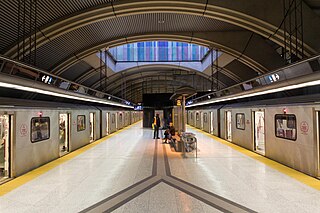
A tunnel is an underground or undersea passageway. It is dug through surrounding soil, earth or rock, or laid under water, and is enclosed except for the portals, commonly at each end. A pipeline is not a tunnel, though some recent tunnels have used immersed tube construction techniques rather than traditional tunnel boring methods.

Crossrail was a railway construction project centred around London. It aimed to provide a high-frequency hybrid commuter rail and rapid transit system crossing the capital from suburbs on the west to east, by connecting two major railway lines terminating in London: the Great Western Main Line and the Great Eastern Main Line. The project was approved in 2007, and construction began in 2009 on the central section and connections to existing lines that became part of the route, which has been named the Elizabeth line in honour of Queen Elizabeth II who opened the line on 17 May 2022 during her Platinum Jubilee. The central section of the line between Paddington and Abbey Wood opened on 24 May 2022, with 12 trains per hour running in each direction through the core section in Central London.
The Second Avenue Subway is a New York City Subway line that runs under Second Avenue on the East Side of Manhattan. The first phase of this new line, with three new stations on Manhattan's Upper East Side, opened on January 1, 2017. The full Second Avenue Line, if and when it will be funded, will be built in three more phases to eventually connect Harlem–125th Street in Harlem to Hanover Square in Lower Manhattan. The proposed full line would be 8.5 miles (13.7 km) and 16 stations long, serve a projected 560,000 daily riders, and cost more than $17 billion.

A tunnel boring machine (TBM), also known as a "mole", is a machine used to excavate tunnels. Tunnels are excavated through hard rock, wet or dry soil, or sand, each of which requires specialized technology.

Line 1 Yonge–University is a rapid transit line on the Toronto subway. It serves Toronto and the neighbouring city of Vaughan in Ontario, Canada. It is operated by the Toronto Transit Commission, has 38 stations and is 38.4 km (23.9 mi) in length, making it the longest line on the subway system. It opened as the "Yonge subway" in 1954 as Canada's first underground passenger rail line, and was extended multiple times between 1963 and 2017. Averaging over 670,000 riders per weekday, Line 1 is the busiest rapid transit line in Canada, and one of the busiest lines in North America.

Kaohsiung Metro is a rapid transit and light rail system covering the metropolitan area of Kaohsiung, Taiwan. Its rapid transit network is known as Kaohsiung Mass Rapid Transit or Kaohsiung MRT. Construction of the MRT started in October 2001. The MRT opened in 2008 and the Circular light rail in 2015. Kaohsiung Metro is operated by the Kaohsiung Rapid Transit Corporation under a BOT contract the company signed with the Kaohsiung City Government.
William R. Allen Road, also known as Allen Road, the Allen Expressway and colloquially as the Allen, is a short expressway and arterial road in Toronto. It starts as a controlled-access expressway at Eglinton Avenue West, heading north to just south of Transit Road, then continues as an arterial road north to Kennard Avenue, where it continues as Dufferin Street. Allen Road is named after Metro Toronto chairman William R. Allen and is maintained by the City of Toronto. Landmarks along the road include the Lawrence Heights housing project, Yorkdale Shopping Centre and Downsview Park, and Downsview Airport. A section of the Line 1 Yonge–University subway is located within the median of the expressway from Eglinton Avenue to north of Wilson Avenue.

Sheppard West is a subway station on Line 1 Yonge–University in Toronto, Ontario, Canada. The station, which is located at the southeast corner of Sheppard Avenue West–Allen Road intersection, opened in 1996 in what was then the City of North York, and the large commuter parking lot, accessible via Allen Road and Sheppard Avenue, opened in July 2005. It was the northern terminus of the western branch of the line until the opening of the six stations of the line's extension north to the City of Vaughan's new downtown core on December 17, 2017.

Eglinton West is a subway station on Line 1 Yonge–University in Toronto, Ontario, Canada. It is located in the median of Allen Road on the north side of Eglinton Avenue West.

St. Clair West is a subway station on Line 1 Yonge–University in Toronto, Ontario, Canada. It spans the block north of St. Clair Avenue West to Heath Street, between Bathurst Street and Tweedsmuir Avenue. The station serves the local communities of Forest Hill South, Humewood, Bracondale Hill and Casa Loma.

Spadina is a subway station on Line 1 Yonge–University and Line 2 Bloor–Danforth in Toronto, Ontario, Canada. It is located on Spadina Road, north of Bloor Street West. It is one of only two stations open overnight, along with Union station. Wi-Fi service is available at this station.

Union is a subway station on Line 1 Yonge–University of the Toronto subway in Toronto, Ontario, Canada. It opened in 1954 as one of twelve original stations on the first phase of the Yonge line, the first rapid transit line in Canada. It was the southern terminus of the line until the opening of the University line in 1963, and is today the inflection point of the U-shaped line. Along with Spadina station, it is one of two stations open overnight to support late-night streetcar routes.

Finch West is a subway station on the Line 1 Yonge–University of the Toronto subway. It is located under Keele Street, north of Finch Avenue West. When Line 6 Finch West opens in late 2024, it will serve as the eastern terminus of that line.

The history of rapid transit began in London with the opening of the Metropolitan Railway, which is now part of the London Underground, in 1863. By World War I, electric underground railways were being used in Athens, Berlin, Boston, Buenos Aires, Budapest, Glasgow, Hamburg, Istanbul, Liverpool, New York City, Paris, and Philadelphia.

Line 5 Eglinton is a light rail line that is under construction in Toronto, Ontario, Canada. Owned by Metrolinx and operated by the Toronto Transit Commission (TTC), the line will be part of the Toronto subway system as its fifth route. The first phase of the 19-kilometre (12 mi) line will include 25 stops along Eglinton Avenue, from Mount Dennis station mostly underground to Laird station, after which it will run predominantly at-grade within the street's median to Kennedy station, where it will connect underground with Line 2 Bloor–Danforth. The second phase, a 9.2-kilometre (5.7 mi) westward extension from Mount Dennis, will run mostly underground or elevated to Renforth station, with seven new stations.

Rapid transit or mass rapid transit (MRT), also known as heavy rail or metro, is a type of high-capacity public transport that is generally built in urban areas. A rapid transit system that primarily or traditionally runs below the surface may be called a subway, tube, or underground. Unlike buses or trams, rapid transit systems are railways, usually electric, that operate on an exclusive right-of-way, which cannot be accessed by pedestrians or other vehicles. They are often grade-separated in tunnels or on elevated railways.

Airport Central railway station is an underground Transperth commuter rail station at terminals one and two of Perth Airport in Western Australia. The station is located on the Airport line and is one of three stations that were built as part of the Forrestfield–Airport Link project.

Prince Edward Road MRT station is a future underground Mass Rapid Transit (MRT) station on the Circle line in Downtown Core, Singapore. This station is part of Stage 6 of the Circle line which will "close the circle" between the HarbourFront and Marina Bay stations. It is built along Shenton Way, near the junctions of Keppel Road and Palmer Road.
The Toronto Transit Commission (TTC) maintains three rapid transit lines and 75 stations on 76.9 km (47.8 mi) of route.

Tunnels are dug in types of materials varying from soft clay to hard rock. The method of tunnel construction depends on such factors as the ground conditions, the ground water conditions, the length and diameter of the tunnel drive, the depth of the tunnel, the logistics of supporting the tunnel excavation, the final use and shape of the tunnel and appropriate risk management. Tunnel construction is a subset of underground construction.
















